I like to think that Baxter and I have a pretty good idea of the range of physical abilities that yoga practitioners have in the real world. We’ve seen some pretty fancy stuff in person, such as crazy arm balances and impossible-looking backbends. But we also know that that the average person, especially the average middle-aged or older person, isn’t able to do the fancy stuff and sometimes even the classic stuff, such as Triangle pose (Trikonasana) with the bottom hand on the floor. In fact, even Baxter uses a block in that pose (and see how happy he looks!).
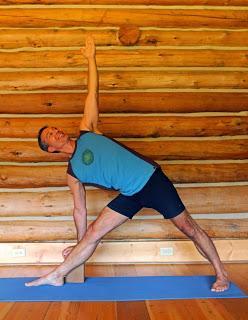 And because our blog is pragmatic, rather than inspirational or aspirational, we are committed to making sure the poses and sequences we describe are actually accessible to most people, if not all. (The exception would be some of our challenging sequences, such as the Challenging Agility Practice.) This is why recently Baxter and I have been working together on choosing a basic set of essential yoga asanas (you’ve been seeing some of those in our recent Featured Pose posts) with four different versions for each pose. The first version is always the classic version (done without props) of the pose. Then we provide three other more accessible versions. Sometimes the accessible versions use props, which help make the pose safer, more comfortable, or just plain doable for people (see 7 Reasons Why You Should Love Yoga Props). For example, this version of Upward Plank pose (Purvottanasana) with chair makes the pose accessible to people who can’t do the classic version without major straining or discomfort.
And because our blog is pragmatic, rather than inspirational or aspirational, we are committed to making sure the poses and sequences we describe are actually accessible to most people, if not all. (The exception would be some of our challenging sequences, such as the Challenging Agility Practice.) This is why recently Baxter and I have been working together on choosing a basic set of essential yoga asanas (you’ve been seeing some of those in our recent Featured Pose posts) with four different versions for each pose. The first version is always the classic version (done without props) of the pose. Then we provide three other more accessible versions. Sometimes the accessible versions use props, which help make the pose safer, more comfortable, or just plain doable for people (see 7 Reasons Why You Should Love Yoga Props). For example, this version of Upward Plank pose (Purvottanasana) with chair makes the pose accessible to people who can’t do the classic version without major straining or discomfort.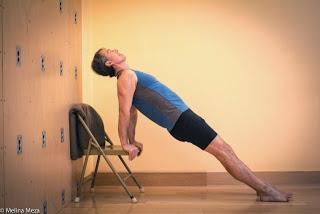 Other times, when a prop can’t really help, we simply change up the pose. An example of this is Side Plank pose (Vasithasana). In our post Featured Pose: Side Plank Pose, the first two variations of the classic pose, don’t use props but instead a slightly different shape to the pose (the first with a different foot position and the second with a different arm position):
Other times, when a prop can’t really help, we simply change up the pose. An example of this is Side Plank pose (Vasithasana). In our post Featured Pose: Side Plank Pose, the first two variations of the classic pose, don’t use props but instead a slightly different shape to the pose (the first with a different foot position and the second with a different arm position): 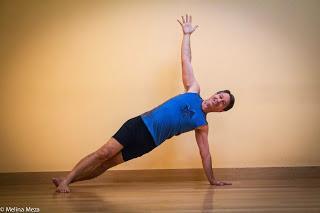
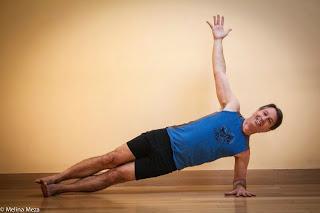 The final version reorients the pose completely, so you’re standing upright instead of balancing on the edge of your feet.
The final version reorients the pose completely, so you’re standing upright instead of balancing on the edge of your feet. 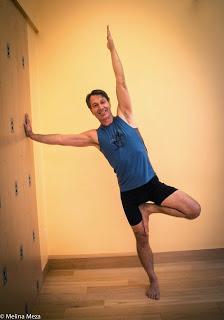 Now you might be wondering why, if we’re so committed to being “accessible,” we don’t include chair versions of every single pose, such as Side Plank pose, so that people who can’t stand unaided, such as seniors and disabilities, can do all the poses. We do think that the chair versions of standing poses are truly wonderful and not necessarily for wimps (see In Praise of Chair Yoga). Here’s a good example of Warrior 2 done in a chair by the great teacher Eric Small:
Now you might be wondering why, if we’re so committed to being “accessible,” we don’t include chair versions of every single pose, such as Side Plank pose, so that people who can’t stand unaided, such as seniors and disabilities, can do all the poses. We do think that the chair versions of standing poses are truly wonderful and not necessarily for wimps (see In Praise of Chair Yoga). Here’s a good example of Warrior 2 done in a chair by the great teacher Eric Small: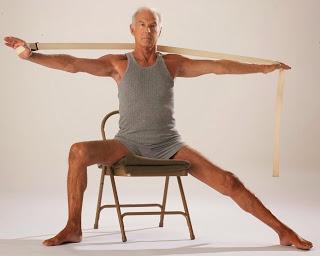 Although in the future, we will include chair versions of some of the classic standing poses, we have decided not to include chair variations of every single pose because our blog is aimed at a different audience. Our intended audience is both middle aged and older people who want to use their yoga practice to foster healthy aging (see What is Healthy Aging, Anyway?). So we assume that you (or your students) can stand unaided, can get up and down from the floor, and are relatively healthy or are in recovery from illness. This is why even though many of our poses and practices can be used by people who cannot stand unaided and need to practice in chairs or wheelchairs (office yoga poses and some chair poses, breath practices, meditation practices, yoga philosophy), we don’t have specific instructions for these groups. Of course, we do think that yoga can provide great benefits to those populations, but that’s just not our target audience. But rest assured that are many great resources out there for these groups, whether that is Sam Dworkis’ book Recovery Yoga, Eric Small’s book on Yoga for Multiple Sclerosis (which has great photographs of chair and wheelchair yoga), or Timothy McCall’s Yoga As Medicine (which includes some excellent poses for people who cannot stand unaided). Subscribe to Yoga for Healthy Aging by Email ° Follow Yoga for Healthy Aging on Facebook ° Join this site with Google Friend Connect
Although in the future, we will include chair versions of some of the classic standing poses, we have decided not to include chair variations of every single pose because our blog is aimed at a different audience. Our intended audience is both middle aged and older people who want to use their yoga practice to foster healthy aging (see What is Healthy Aging, Anyway?). So we assume that you (or your students) can stand unaided, can get up and down from the floor, and are relatively healthy or are in recovery from illness. This is why even though many of our poses and practices can be used by people who cannot stand unaided and need to practice in chairs or wheelchairs (office yoga poses and some chair poses, breath practices, meditation practices, yoga philosophy), we don’t have specific instructions for these groups. Of course, we do think that yoga can provide great benefits to those populations, but that’s just not our target audience. But rest assured that are many great resources out there for these groups, whether that is Sam Dworkis’ book Recovery Yoga, Eric Small’s book on Yoga for Multiple Sclerosis (which has great photographs of chair and wheelchair yoga), or Timothy McCall’s Yoga As Medicine (which includes some excellent poses for people who cannot stand unaided). Subscribe to Yoga for Healthy Aging by Email ° Follow Yoga for Healthy Aging on Facebook ° Join this site with Google Friend Connect

